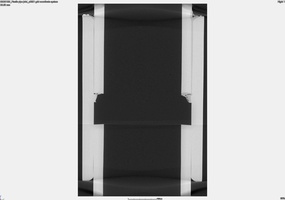A CT scan is used to show a CPVC pipe inserted into the top of a CPVC union with solvent cement. This non-destructive image reveals that there was no solvent cement applied to the bottom pipe and union joint.
Through many years of studying fracture characteristics of polymers, difficult to understand fracture surfaces are interpreted correctly. This composite image of 16 high magnification images from an electron microscope reveals the complexity of the fracture, as well as showing details related to the speed of fracture, the environmental effects at the time of failure, and the applicable stresses on the part that initiated the fracture.
Pultruded plastic parts rely on the correct interactions of polymer matrix with the fiber bundles that provide the stiffness and strength for these highly reinforced parts (ladders, beams, etc.). This image shows that there are cracks inside the plastic. These cracks can coalesce and cause catastrophic failure of the entire structure.
Each fracture surface in a failed plastic part provides a wealth of detailed information about how the failure occurred. Here is seen evidence of a brittle fracture in what was considered a ductile polymer. Such anomalies need to be considered and understood to reach the real root cause of a broken plastic part.




